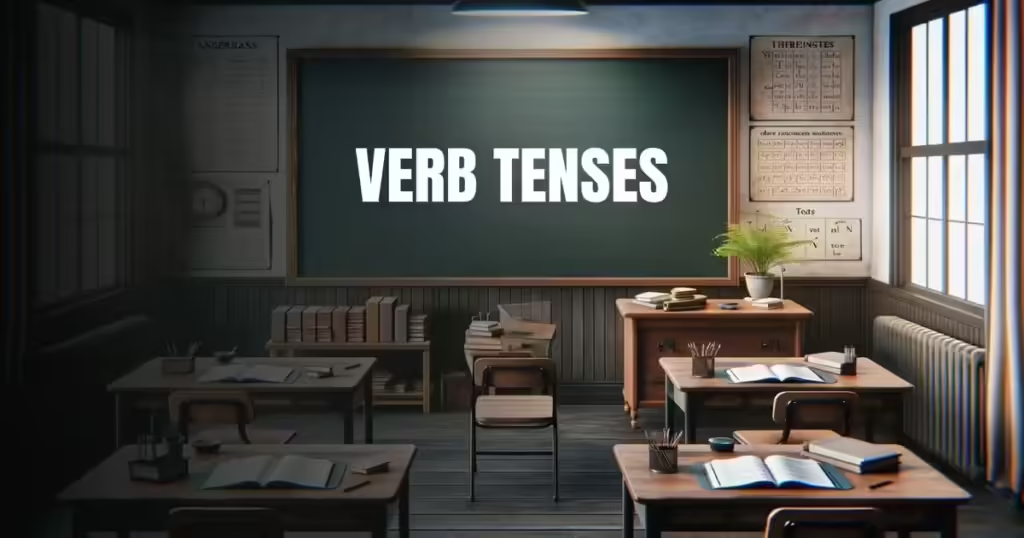Ever feel like your verbs are playing a game of hide-and-seek, leaving your sentences unfinished and your meaning muddled? This is where Verb Conjugation comes in!
Past, present, future – it’s enough to make anyone’s head spin! But fret no more, fellow language enthusiasts! This is no stuffy grammar treatise. We’re about to unlock the secrets of verb conjugation in a way that’s as fun as it is informative.
Get ready to ditch the confusion and embrace clarity. We’ll navigate the time-bending world of tenses with ease, master the moods that color your writing, and tame those pesky verb forms that trip up even the best of us.
No more struggling with “was” or “were,” “is” or “am.” You’ll be wielding verbs like a seasoned wordsmith, leaving grammatical blunders in your dust.
But this isn’t just about ticking off boxes on a checklist. This is about infusing your writing with power and precision. Imagine crafting emails that land like thunderbolts, essays that mesmerize, and presentations that leave audiences spellbound.
No more fumbling for the right verb or feeling lost in a maze of tenses. You’ll be speaking and writing with newfound confidence, making your message heard loud and clear.
So, put down that rusty rulebook and grab your curiosity! This verb-taming journey is about to take off. Get ready to transform your understanding of grammar and unleash the power of your words. Dive in, and let the clarity begin!
Ready to conquer verbs and elevate your writing? Head over to ” English Verb Conjugation: A Lesson In Grammar Rules” and let’s get started!

Understanding the Basics of English Verb Conjugation
In the world of the English language, tenses serve as threads that weave together the fabric of communication. They are fundamental to expressing time, indicating when an action happens, happens, or will happen. Without tenses, our sentences would be temporal orphans, devoid of context and clarity.
The Role of Tenses in the English Language
At the very heart of English grammar, tenses do more than just signal the timing of an action. They help convey a speaker’s attitude, and complete thoughts, and create coherence in discourse. Tenses set the stage for storytelling, argumentation, and description, providing a temporal anchor for the listener or reader.
Overview of Primary Tenses: Past, Present, Future
The English language categorizes tenses into three primary times: past, present, and future. Each of these is further divided into four aspects: simple, continuous (also known as progressive), perfect, and perfect continuous.
This system allows for a precise expression of time and action, whether it’s a momentary event, a prolonged activity, a completed action, or an ongoing process.
Tenses and Their Time Frames
This section serves as a foundational bedrock for understanding the more intricate aspects of each tense, which will be explored in the following sections. By grasping these basics, learners can start to navigate the rich and sometimes complex terrain of English verb tenses.
Detailed Exploration of Each Tense
English tenses, with their varied forms and uses, are like the colors on a painter’s palette – each adding a unique shade to the language’s expression.
This section will meticulously explore each tense, providing insights into their form and usage.
Present Tense: Simple, Continuous, Perfect, Perfect Continuous
Past Tense: Simple, Continuous, Perfect, Perfect Continuous
Future Tense: Simple, Continuous, Perfect, Perfect Continuous
Each of these tenses has a specific form and purpose, allowing for nuanced expression in the English language. Understanding their intricacies is key to mastering English grammar and effective communication.

Conjugations: The Backbone of English Tenses
Conjugation, the modification of verbs from their base form, is the linchpin in the machinery of English tenses. It’s through conjugation that verbs morph to align with different subjects, tenses, and aspects, thereby conveying precise meanings.
Conjugation Basics: Subject-Verb Agreement
The fundamental rule of conjugation in English is the subject-verb agreement. It ensures that the verb form matches the subject in number (singular or plural) and person (first, second, or third).
For example, in the simple present tense, we add an “-s” or “-es” to the verb when the subject is a third-person singular noun or pronoun: “She runs”, “The cat sleeps”.
Regular vs. Irregular Verbs
Understanding the difference between regular and irregular verbs is crucial in mastering English conjugation.
Regular verbs follow a predictable pattern in their past and past participle forms (e.g., walk-walked-walked), while irregular verbs do not adhere to these norms and must be memorized (e.g., go-went-gone).
Conjugating in Different Tenses
Conjugation changes with each tense. For instance, the past tense of a regular verb is typically formed by adding “-ed” to the base form.
However, irregular verbs vary significantly, requiring a more nuanced understanding. For example, the past tense of “sing” is “sang,” and its past participle is “sung.”
This understanding of conjugation is essential not just for correct grammar but also for effective communication. The nuances in verb forms can subtly change the meaning and clarity of a sentence.
Practical Applications and Usage
Understanding verb tenses and conjugations is not just an academic exercise; it’s a skill that enhances communication in real-world scenarios. This section focuses on the practical applications of these grammatical principles.
Choosing the Right Tense for Different Contexts
The art of choosing the appropriate tense is crucial for clear communication. Different scenarios call for different tenses. For instance, while discussing historical events, the past tense is used, whereas the present tense is suitable for universal truths or habitual actions.
Selecting the correct tense helps the listener or reader understand the time frame and nature of the action or event being described.
Common Mistakes and How to Avoid Them
One of the most common pitfalls in using English tenses is the incorrect matching of time frames, leading to confusion. Another frequent error is the misuse of irregular verb forms.
This section provides tips on avoiding these mistakes, such as paying attention to time cues in sentences and familiarizing oneself with common irregular verbs.
Tense Usage in Professional and Academic Writing
In professional and academic settings, the precision of tense usage is even more critical.
For example, in academic writing, the present tense is often used when discussing established knowledge, while the past tense is used for reporting completed research. In business communication, the future tense can be used to discuss plans and projections.

Mastering English Verb Tenses and Conjugations: Strategies and Tips
Gaining proficiency in English tenses and conjugations is a gradual process that involves understanding, practice, and application. This section provides strategies and tips to help you master these essential aspects of the English language.
Developing a Strong Foundation
Start by solidifying your understanding of the basic concepts. Ensure you have a firm grasp of the different tenses and their uses, as well as the rules for regular and irregular verb conjugations.
Practical Application through Writing and Speaking
Apply what you’ve learned by incorporating various tenses in your daily writing and speaking. Practice writing sentences or short paragraphs using different tenses, and try to use them in your conversations. This real-life application is invaluable for reinforcing your learning.
Creating Personalized Learning Aids
Develop your study aids such as flashcards, charts, or diagrams that illustrate different tense forms and conjugation rules. Personalized learning materials can be very effective in helping you remember and understand complex grammatical structures.
Engaging in Self-Review and Reflection
Regularly review your writing and speech to identify areas for improvement. Reflecting on your usage of tenses and conjugations, and correcting your mistakes, can lead to significant progress over time.
Seeking Constructive Feedback
Whenever possible, seek feedback from proficient English speakers or educators. Constructive criticism can provide you with insights into your usage of tenses and conjugations and help you correct common errors.

What Are Common Verb Tense Mistakes in English
Verb tense mistakes are frequent hurdles in the journey of learning English. Being aware of these common errors can significantly improve your language proficiency. Here are several typical verb tense mistakes and how to avoid them:
Confusing Tenses in Narratives
A common error is mixing tenses within a narrative. Ensure consistency in your tense usage, especially when describing events in the past, present, or future. For instance, instead of saying, “Last week I go to the beach,” use the past tense, “Last week I went to the beach.”
Misusing Verb Forms
Selecting the incorrect verb form can alter the intended meaning of a sentence. Pay attention to the correct form for each tense. For example, “She is swimming” is correct, whereas “She is swim” is not.
Omitting Necessary Verbs
In English, omitting essential verbs can lead to incomplete or unclear sentences. Always include the necessary verbs for your sentence to make sense. For instance, say “I am excited about the trip,” instead of “I excited about the trip.”
Misapplying Stative Verbs in Continuous Tenses
Stative verbs, which describe a state rather than an action, typically do not appear in continuous tenses. For example, it’s correct to say “I like apples,” but incorrect to say “I am liking apples.” However, there are exceptions, particularly when a change of state is implied.
Incorrect Use of Gerunds After Prepositions
After prepositions, a gerund (verb + -ing) is generally used instead of a bare infinitive. For instance, “We discussed going to the cinema,” is correct, while “We discussed going to the cinema,” is not.
Overuse of the Present Perfect Tense
While the present perfect tense is useful, it’s often overused. This tense should be used for actions that have an unspecified time before now or continue to the present. For instance, “I have lived here for five years” (continuing action) is a correct usage.
Choosing Between Infinitives and Gerunds
The choice between using an infinitive (to + verb) or a gerund (-ing form) can be tricky. Often, it depends on the main verb or the preposition used in the sentence. For instance, “I prefer reading” is correct, whereas “I prefer to read” is not.
Avoiding Modifier Misplacement
Modifiers should be placed close to the word or phrase they are modifying to avoid confusion.
Misplacement can lead to humorous or unclear sentences. For example, “She saw a kitten climbing a tree on her walk,” is clearer than, “On her walk, she saw a kitten climbing a tree.”
By being mindful of these common mistakes, you can navigate the complexities of English tenses more effectively and communicate more clearly and accurately.
Final Takeaway
As we conclude our comprehensive journey through the realms of English verb tenses and conjugations, it’s important to reflect on the significance of these grammatical elements in mastering the English language.
Tenses are not just grammatical constructs; they are the essence of communication, allowing us to express time, sequence, and subtleties of meaning with precision and clarity.
The Power of Tenses in Expressive Language
English tenses empower speakers and writers to convey thoughts and actions across different time frames.
Whether it’s narrating past events, describing present conditions, or planning for the future, each tense serves a unique purpose. They enrich storytelling, enhance descriptive writing, and clarify communication in both formal and informal contexts.
The Role of Conjugations in Accurate Communication
Conjugations, on the other hand, are the backbone of tenses. They ensure that verbs align correctly with their subjects, providing the grammatical accuracy essential for clear and effective communication.
Understanding the nuances of regular and irregular verb conjugations is crucial, as it affects not only the correctness but also the natural flow of language.
Continuous Learning and Practice: The Path to Proficiency
Mastering English tenses and conjugations is a continuous learning process. It requires patience, practice, and a keen eye for detail.
Regular practice, through writing and conversation, helps solidify these concepts. Engaging with diverse reading materials, participating in language exercises, and seeking feedback from proficient speakers can further enhance your understanding and usage of English tenses.
Embracing the Journey
Ultimately, the journey of mastering English tenses and conjugations is a rewarding one. It opens up new horizons in understanding and communication, allowing you to express yourself more effectively and connect with others more deeply.
Embrace this journey with enthusiasm and curiosity, and you’ll find your command of the English language continually improving.

